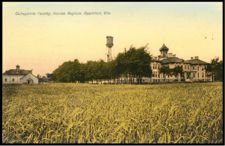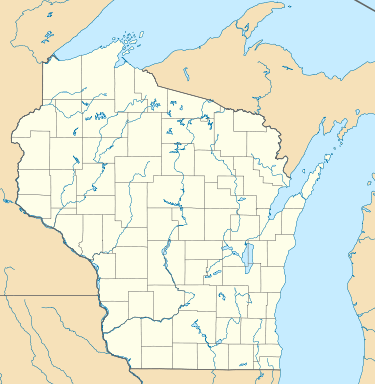Outagamie County Health Center
| Outagamie County Health Center | |
|---|---|
 Outagamie County Insane Asylum, Appleton, Wisconsin, 1916 | |
 Location in Wisconsin / United States  Outagamie County Health Center (the US) | |
| Geography | |
| Location | Appleton, Wisconsin, United States |
| Coordinates | 44°16′37″N 88°27′36″W / 44.277°N 88.460°WCoordinates: 44°16′37″N 88°27′36″W / 44.277°N 88.460°W |
| History | |
| Founded | 1889 |
| Demolished | 2001 |
| Links | |
| Lists | Hospitals in Wisconsin |
Outagamie County Health Center, established in 1889, was a psychiatric hospital serving Outagamie County, Wisconsin. It was first named Outagamie County Asylum for the Chronic Insane, then Outagamie County Hospital, and finally Outagamie County Health Center.[1]
History
On January 25, 1889, the Outagamie County board of supervisors voted to purchase 320 acres of land west of the city of Appleton for $15,000, for the purpose of erecting a county asylum for the chronic insane. Original plans expected the asylum to accommodate 100 individuals, and to cost approximately $40,000 to build.[2] The finished facility was granted accreditation in early January 1890,[3] and George R. Downer became the first superintendent of the Outagamie County Asylum,[4][5] a position he would hold for 25 years. By 1894, an inspection of the asylum and adjoining farm, which was staffed by patients, was described as self-sustaining[6] and the following year it had a net profit of $9,000.[7][lower-alpha 1]
Reyfeldt lawsuit
On May 3, 1913, a lawsuit was brought against asylum superintendent George Downer. It was filed on behalf of patient John Rehfeldt by his legal guardian.[9] The lawsuit, seeking $10,000 in damages, alleged that Downer approved an "illegal operation", which was revealed to be the castration of Rehfeldt and other unnamed patients.[9] The lawsuit also sought the identities of any co-defendants who performed the operation. At the May 3 hearing, when asked this, Downer invoked his fifth amendment right against self-incrimination.[10] On May 24, the physician who performed the castration was named as a co-defendant and was revealed to be James V. Canavan, who by 1913 was the 31st mayor of Appleton, Wisconsin.
Canavan, still Appleton's city mayor, died on December 4, 1913.[11] The Reyfeldt civil lawsuit was still in process in early 1915, and on January 1, 1915, George Downer was succeeded by Thomas Flanagan as asylum superintendent.[12] On April 26, 1915, George Downer committed suicide by jumping off an Appleton bridge.[4] Speculation that the Reyfeldt lawsuit was a factor in both deaths surfaced as Reyfeldt's story spread to newspapers nationally in November 1915.[13][14][15] Meanwhile, the state of Wisconsin did pass a law, which went into effect in November 1915, allowing for legal compulsory sterilization of "mental defectives".[15]
Asylum conditions and abuses
Thomas Flanagan was asylum superintendent from January 1, 1915[12] until May 4, 1944.[16] In December 1943, 10 former and current employees of the asylum petitioned Outagamie County to investigate conditions at the asylum and specific allegations of patient abuse. It asked for the resignation of the superintendent and other officers.[17] Ultimately an investigation was carried out, and abuses uncovered led to the resignation of Flanagan, his wife (asylum matron), and four additional employees.[1]
Building upgrades
A turning point for the facility came in 1957, when a $1.9 million dollar construction project to upgrade the asylum was begun. In 1956, the existing 150 bed asylum was badly overcrowded and was hosting 268 patients; some wards had 11 to 14 patients per room.[18] The administration building of the asylum would be used as the center of six new dormitory wings, and once residents were moved into the new dormatories, the old would be razed behind them. The new structures as built were called Outagamie County Hospital, in effect renaming the facility once the upgrade was completed in 1958.[19][18] The new building had a capacity of 320 beds, and a maximum of four patients per room.[18]
1966 was the last year that Outagamie County Hospital operated its adjoining farm, Outagamie County Farm, with a patient work force and as a source of hospital funding. Most of the machinery, animals, and excess harvest were sold in a two day auction in December 1966. Gardening and small scale farming would continue "on a limited basis".[20]
Outagamie County Health Center
Outagamie County Hospital was renamed by the Outagamie County board August 10, 1971, in part to prevent confusion about the facility's purpose. With its former name, area residents would come to the site expecting emergency care; examples were given of a burn victim and women in labor coming to the psychiatric hospital expecting conventional medical care only to have to be directed elsewhere. Babies had been delivered onsite for this reason. The board renamed the facility Outagamie County Health Center.[21]
OCHC was rendered obsolete by the construction of Brewster Village in 2000. Brewster Village was built alongside the former facility, employing modern mental health care practices.[1] An OCHC worker who experienced the job before and after the move to Brewster Village stated that "pretty much on a daily basis, we needed to restrain or seclude people. Since moving into (Brewster Village) with pretty much the same population, we have never used a separation room".[22]
The Outagamie County Asylum Cemetery exists north of where the original building stood, and was in use from 1891 to 1943, housing the remains of 133 people.[23] In 2015 an effort was made to improve the nearly forgotten cemetery site, adding memorials and performing caretaking of the long neglected grounds.[23]
A museum exhibit was created in 2016 for the Outagamie County Health Center at History Museum at the Castle, entitled Asylum: Out of the Shadows.[24][25] The exhibit contains photographs, tools, testimonials of those who worked there, and a scenic reconstruction of life at the facility.[24]
Top officials
Superintendents
George R. Downer (January 1890 – January 1, 1915)
Thomas Flanagan (January 1, 1915 – May 4, 1944)
Ralph Voigt (1944? – July 1, 1953)
Norbert F. Loerke (1953 – November 9, 1962)
Thomas Lesselyong (November 10, 1962 – April 30, 1963) (acting)
John A. Engle (May 1, 1963 – March 31, 1967)
Eugene K. Speener (April 1, 1967 – October 1, 1974)
Administrators
Michael C. Theiss (December 1974 – January 1977)[26]
After Theiss's resignation in January 1977, the Outagamie County board created a five member panel to assume the former duties of the Outagamie County Health Center superintendent.[27]
Notes
References
- 1 2 3 "Insane asylum cemetery: Forgotten stories". Post-Crescent Media. August 14, 2014. Retrieved March 1, 2017.
- ↑ "Outagamie - Will Bulid". The Oshkosh Northwestern. January 26, 1889. p. 1. Retrieved March 2, 2017 – via Newspapers.com.
- ↑ "State News". Green Bay Press-Gazette. January 11, 1890. p. 3. Retrieved March 2, 2017 – via Newspapers.com.
- 1 2 "Asylum Head is a Suicide". Stevens Point Daily Journal. April 26, 1915. p. 2. Retrieved March 2, 2017 – via Newspapers.com.
- ↑ "History of Outagamie County - Part 8". www.foxvalleymemory.org. Retrieved 2017-03-02.
- ↑ "Kaukauna Tidings". Green Bay Weekly Gazette. October 17, 1894. p. 4. Retrieved March 2, 2017 – via Newspapers.com.
- ↑ "On the Stump". Green Bay Press-Gazette. January 4, 1896. p. 4. Retrieved March 2, 2017 – via Newspapers.com.
- ↑ "Killed by Enraged Bull". Green Bay Semi-Weekly Gazette. August 16, 1899. p. 1. Retrieved March 2, 2017 – via Newspapers.com.
- 1 2 "Sensation at Appleton". Eau Claire Leader. May 4, 1913. p. 4. Retrieved 2017-03-02 – via Newspapers.com.
- ↑ "Mayor of Appleton Sued". The Oshkosh Northwestern. May 24, 1913. Retrieved 2017-03-02 – via Newspapers.com.
- ↑ "Mayor of Appleton Dies". Eau Claire Leader. p. 4. Retrieved 2017-03-02 – via Newspapers.com.
- 1 2 "County Has Half Million Invested In Its Asylum". The Post-Crescent. April 30, 1932. p. 65. Retrieved 2017-03-02 – via Newspapers.com.
- ↑ "State Dooms 24 Men". The Tacoma Times. November 29, 1915. p. 1. Retrieved 2017-03-02 – via Newspapers.com.
- ↑ "Sterilization Brought Four Big Tragedies". Evansville Press. November 13, 1915. pp. 1, 6. Retrieved 2017-03-02 – via Newspapers.com.
- 1 2 "First Sterilization Brought Tragedy". The Day Book. November 17, 1915. pp. 1–2. Retrieved 2017-03-02 – via Newspapers.com.
- ↑ "Cruelties at Hospital". The Sheboygan Press. p. 30. Retrieved 2017-03-02 – via Newspapers.com.
- ↑ "Probe of Asylum At Appleton by D.A.; Board Asked". Green Bay Press-Gazette. December 29, 1943. p. 15. Retrieved 2017-03-02 – via Newspapers.com.
- 1 2 3 "County Hospital Building is a Symbol of Progress". The Post-Crescent. September 8, 1960. p. B4. Retrieved 2017-03-02 – via Newspapers.com.
- ↑ "'57 Significant Building Year For All Hospitals In Fox Cities". The Post-Crescent. February 14, 1958. p. D2. Retrieved 2017-03-02 – via Newspapers.com.
- ↑ "County Farm Closes Out Operation at 2-Day Auction". The Post-Crescent. December 9, 1966. p. B1. Retrieved 2017-03-02 – via Newspapers.com.
- ↑ "Hospital Now Health Center". The Post-Crescent. August 10, 1971. p. B1. Retrieved 2017-03-02 – via Newspapers.com.
- ↑ ""A lot of curiosity:" Exhibit at Appleton history museum explores Outagamie County's Asylum for the Insane". FOX6Now.com. 2016-11-21. Retrieved 2017-03-02.
- 1 2 "Work begins at Outagamie County asylum cemetery". Post-Crescent Media. Retrieved March 1, 2017.
- 1 2 "Community/ Out of the Shadows". RIVER + BAY. November 21, 2016. Retrieved March 1, 2017.
- ↑ "Asylum". The History Museum at the Castle. Retrieved March 1, 2017.
- ↑ "Nursing home partner, administrator is named". The Oshkosh Northwestern. January 6, 1977. p. 21-4. Retrieved 2017-03-04 – via Newspapers.com.
- ↑ Knutson, Bill (December 30, 1976). "Nursing chief reinstated". The Post-Crescent. p. B-1. Retrieved 2017-03-04 – via Newspapers.com.